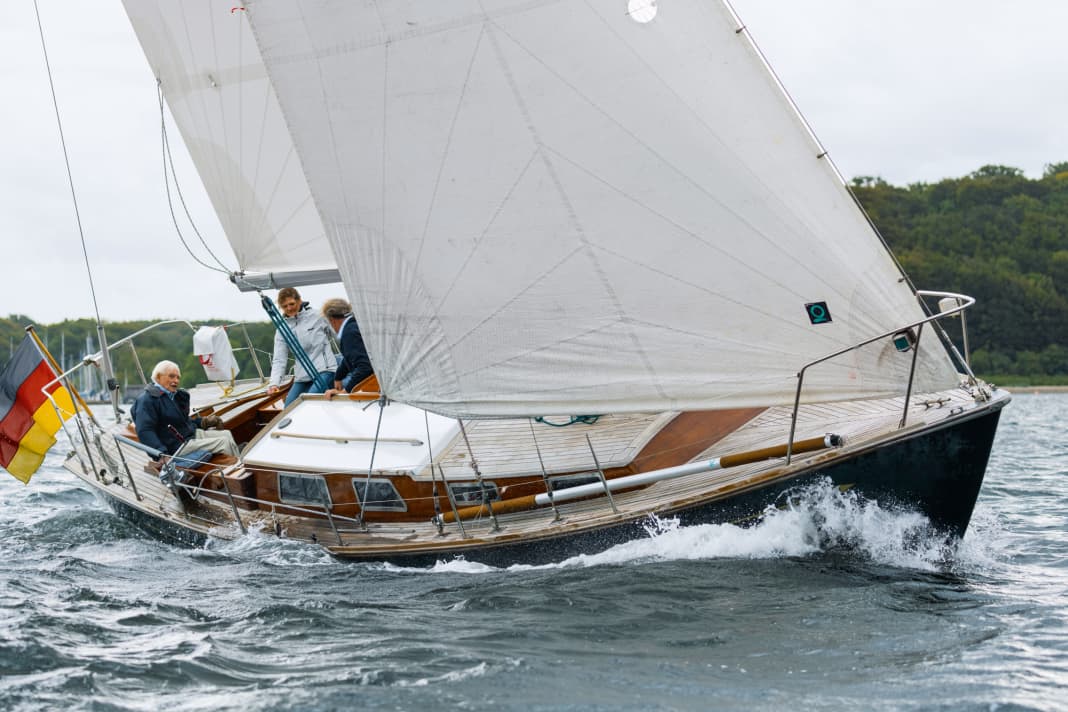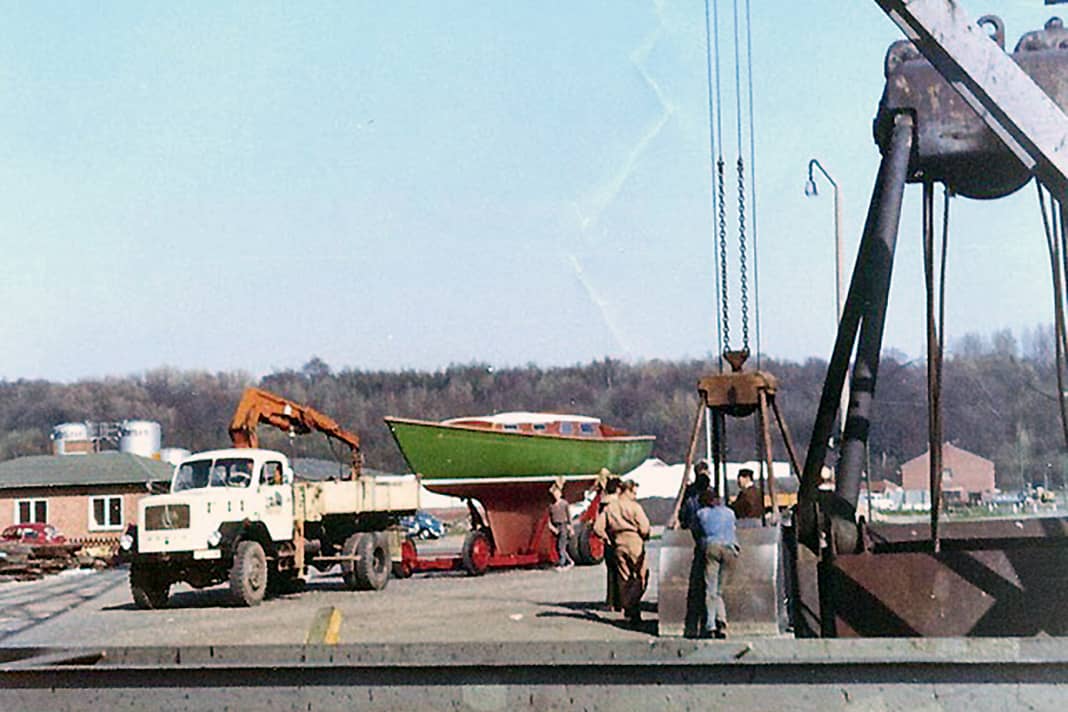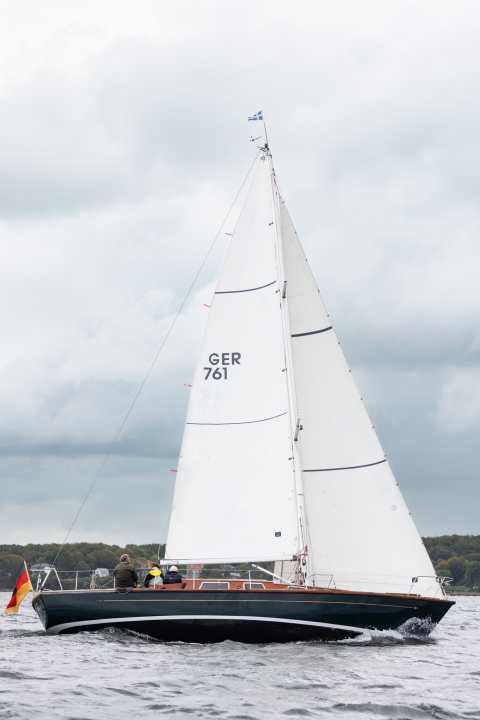





When the wind blows from the west on the fjord, you hardly notice it in the harbour of the Flensburg Sailing Club near Glücksburg. Tall trees shield the jetties and suggest deceptive calm. But for the crew of the "Hans Uhl", the conditions on the fjord on this Tuesday at the end of September are of secondary importance anyway.
5 Beaufort and rain? That's fine for one of the last sailing days of the season. The old lady doesn't have heating - which is one of the reasons why she will be craned in a few days. The season is over.
It is not only the lack of a permanently installed heat source below deck that distinguishes the eleven-metre Regent cruiser from many of the yachts moored here in the harbour. Most of them have modern lines with a high freeboard and polished white hull. "Hans Uhl", on the other hand, ducks between them with a flat superstructure and slender lines.
The Regent is made of GRP
From a distance, the dark green hull shines almost black, while the long, narrow deck radiates functionality and seaworthiness. Some passers-by even stopped when the "Hans Uhl" was on tour through the Baltic Sea harbours, says owner Hans Köster. What a beautiful wooden ship, they praised.
But they are mistaken: the dark green paint does not conceal a planked wooden hull, but GRP. With its wooden superstructure and teak deck, the boat is still considered a true classic by many at first glance - not least because of its age and the effort that goes into maintaining it. And has been for over 50 years!
The "Hans Uhl" was launched for the first time in the spring of 1970. Since then, she has travelled countless miles and undergone a number of changes. The fact that the ship exists in this form at all is due to Jens Köster's industriousness. He is now 89 years old and the father of the current owner Hans Köster.
Köster senior grows up on the fjord. He was drawn to the water early on. In the mid-sixties, the time was ripe for his first own boat: an eight-metre-long steel Wibo. This boat is already dark green in colour and is moored at a buoy between the Ox Islands on the fjord.
The extension is installed in the hull of the Regent
When son Hans was born in 1968, the Wibo proved to be too small; a larger boat suitable for the family was needed. The boat-hunting project begins: Jens Köster looks around, but is not enthusiastic about any of the GRP production boats that are emerging at the time. Finally, he comes across an advert in YACHT: "Regent, also suitable for self-construction." The Wallhausen yacht yard on Lake Constance offered this type of boat, which was produced in small series, as a shell for conversion.
The idea inspires Jens Köster. He orders a hull shell, which is transported by rail across Germany to the north. Köster pays around 5,000 Deutschmarks for the rudder system and freight - a fraction of what a finished ship would have cost. But the hull of the boat is still bare. "There was a rough plan for the extension," says the 89-year-old today on board his old ship. "But we changed it."
He had already looked for and found a boat builder for the work before the purchase. Hans-Christian Isaack customises the boat according to Köster's individual ideas. He christened it "Hans Uhl" in honour of his two children Hans and Ulrike. Ulrike, "who is rich in owls", became the Low German Uhl. At the time, no one realised that Kösters' family would continue to sail the ship frequently on the Flensburg Fjord for the next 50 years.
Sailing takes place outside
Jens Köster has always had a special boat in mind. His credo then as now is: "Sailing takes place outside!" In other words, the skipper and crew on the "Hans Uhl" are not separated from the water by a high side, they sit close to it. No high superstructure, not even a sprayhood, blocks the view forwards.
Even below deck, things are rather spartan by today's standards. Jens Köster was all about active sailing, about feeling the freedom of nature. He still lives that today. As the ship rushes across the fjord in 18 knots of wind on this September day, he takes his favourite spot: right at the stern, at the end of the open aft deck, leaning against the pushpit. From there, he enjoys the view forward, of the water, the crew and his old ship.
Back then, before the Baltic Sea became the family's favourite sailing area after the boat was completed, Köster wanted to get a taste of freedom and see blue water. In 1972, he moved the Regent to the Mediterranean for two years and sailed it with friends in stages from Marseille to Lisbon. During the holidays, the family cruised together off Spain.
It was not least adventures like this that awakened his son Hans' enthusiasm for the ship at an early age. A good 20 years ago, when the question arose as to whether he and his wife wanted to buy their own boat or take over the "Hans Uhl", the decision was easy: the character ship should be continued. However, this would require some modifications.
The Regent sails at the front in regattas
They are not the first. You could say that the Regent has undergone an almost record-breaking number of refits since it was built. This begins early on: after returning from the Mediterranean in the mid-seventies, the keel is lengthened for better sailing performance; the draught is now a good two metres instead of 1.65 metres. The ship is also given a higher rig and a new sail plan. Jens Köster now also wants to sail regattas - and not just after them.
Until the 1990s, the "Hans Uhl" was on the list of participants in regional events such as the Speck Regatta, Kalkgrund Regatta and Alsen Rund. The boat is sailed by a regular crew and interested friends. Hans Köster comes on board when he is ten years old.
Decades then passed before the next major makeover: when Hans Köster and his wife took over the ship, there was a lot of work to be done. In the winter of 2003, they take the ship to the Glückstadt yacht shipyard for the first time. "My father says the ship was built there again," says Hans Köster.
Major refit
The main bulkhead and the rudder are renewed, the underwater hull is stripped and rebuilt and new teak is laid on the superstructure. The foredeck walkways are replaced and the old putties are freshly glued in.
When all these and many other small jobs were completed, daughter Mine Köster was born in autumn 2006. The builder's granddaughter has been a permanent crew member right from the start. Today, over 15 years later, the schoolgirl manoeuvres the six-tonne ship out of the harbour as casually as if she had never done anything else. Which - at least when it comes to sailing - is certainly true.
The ship is further adapted for the new generation: in 2011, the deep forecastle on the starboard side is reduced in size to create a fully-fledged dog bunk underneath. It becomes Mine's new realm. Previously, other berths were located in the saloon. However, a galley is now installed there. A refrigerator comes on board for the first time. Previously, everything that needed to be cooled simply disappeared into the deep bilge.
Although the ship continues to transform, its actual purpose remains the same: sporty sailing with the whole family - including regattas. For this purpose, a new rig was put on deck in 2013: It now has a 9/10 rig instead of a top rig and two pairs of spreaders instead of one. At 14.50 metres, the new mast is a good metre higher than the previous one.
Owner emphasises performance with the Regent
You can feel that when sailing: At 5 Beaufort and with an unreefed main, "Hans Uhl" lays on her cheek. Water rushes past to leeward. Up on the edge, wind and rain blow in your face. "Nobody needs a sprayhood," says Hans Köster with the tiller in his hand and laughs. The ship passes the Ox Islands at eight knots. "You're missing out on sailing!" shouts Köster from the edge in the direction of the cabin, where some of the crew have taken shelter from the rain.
Before he started his own family, the lawyer was a sought-after helmsman at regattas and travelled a lot on boats abroad. So it's no wonder that, despite all the tradition, "Hans Uhl" has always emphasised performance.
For example, an anchor is not even attached to the bow. "When we anchor, someone takes it out of the stern peak," says Hans Köster, adding with a laugh: "Or we go alongside friends who anchor their modern ships." They sometimes have a shower at the stern; on the "Hans Uhl" you won't find that kind of comfort. Nevertheless, there are some ingenious solutions: discreet LED lights under the spreaders show guests the way across the deck in the dark.
Below deck, you travel back in time. Even though a lot has changed since 1970, the character of the Regent is still the same: dark, cosy wood everywhere, a small wet room, a navigation table with large drawers and the smell of a ship that knows stories. "The boat builder fitted it out as if it were a real wooden yacht," says Hans Köster. Only those who look through the stanchions on the side can recognise the GRP hull of the boat behind them.
Generation boat
At the time, it was important that there was sleeping space for four people, a toilet and cooking facilities. But even when a proper galley was brought on board for the first time as part of the second major refit, it was hardly ever used: The Kösters prefer to barbecue outside. The aft deck proves to be the perfect place for this.
Sailing on "Hans Uhl" also means living out of a duffel bag: the space is limited to three metres. But there is room for everything important: Flags, books and provisions are stored in lockers, wine in the bilge and a few clothes in the wardrobe in the passageway to the foredeck. Headroom is also limited. Jens Köster's idea was to keep the superstructure as flat as possible.
Today, the senior still sails occasionally: on transfers or the last regatta of the year. He still knows how to do everything. As soon as he returns to the harbour, he leans back against the pushpit. He looks happy. He is certainly proud that the boat is still so loved and sailed.
And somehow a ship like this, which is passed on from generation to generation, is also a very sustainable endeavour, says the first owner - and is therefore absolutely modern again.
How it all began
A boat builder takes on the conversion, the owner himself lends a hand



When Jens Köster was looking for a professional to build the boat, he approached the junior member of the Isaack family of boat builders based on the Ox Islands. "They knew what a boat should look like," says Köster. Hans-Christian Isaack took over the conversion of the shell into a family-friendly sea cruiser. The originally planned aft cabin is dispensed with in favour of an open aft deck.
Technical data of the Regent "Hans Uhl"
- Year of construction:1969/70
- Design engineer:Siegfried Beil
- Shipyard (hull):Yachtwerft Wallhausen, Lake Constance
- Expansion:H.-C. Isaack
- Torso length:11,02 m
- Width: 3,00 m
- Depth:1,96 m
- Weight:approx. 6 tonnes
- Sail area on the wind:60 m²

This article first appeared in YACHT 23/2021 and has been updated for this online version.

